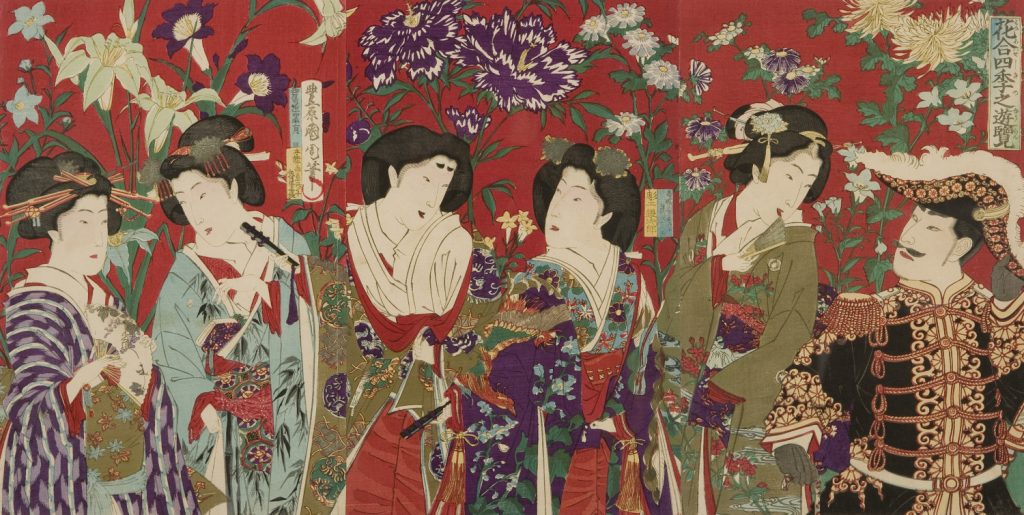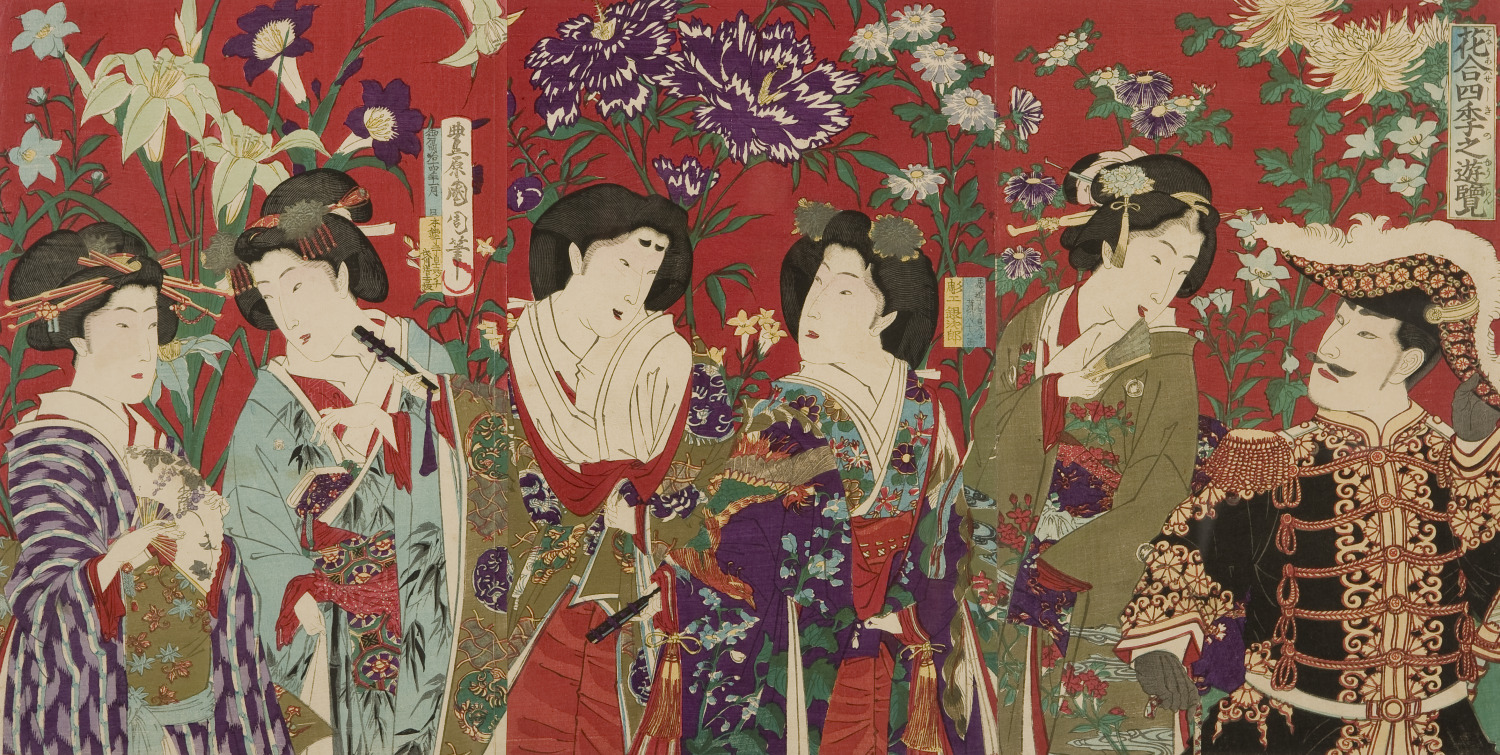ABOUT THE INSTALLATIONS
PhxArt’s Art of Asia collection is home to the Museum’s oldest objects, with a range of works that span 1,000 years and represent numerous countries across the world’s largest continent. Through two special installations, examine Tibetan Buddhist art and exported works that uncover breathtaking regions and significant cultural moments in history.

Kunichika Toyohara, Triptych: The Meiji Emperor Admiring Flowers of the Four Seasons, January 1881. Woodblock print. Museum purchase with funds provided by the Asian Arts Council in honor of G. Miriam E. Kinner. Photo: Ken Howie
Exchanges East and West
Drawn primarily from the Phoenix Art Museum Collection, Exchanges East and West explores a rich period of cross-cultural exchange within Asia and with Europe and the Americas from the 16th through the 20th centuries. During this period, several Asian ceramic production centers made wares to be exported to faraway lands, including the Middle East, Europe and North America. Through the increasing reach of European trading companies, demand from foreign markets and personalized commissions led to the production of wares featuring hybridized forms, European and colonial scenes, and even familial armorial designs for dinnerware, as well as garnitures and figurines.
Ships from China bringing tea into American ports also bore Chinese porcelains that became part of American colonial life. In the late 20th century, undersea archaeology led to the discovery of intact shipwrecks filled with ceramic wares destined for distant ports, including a collection of fine Vietnamese ceramics in the Museum’s collection, sourced from a 15th-century shipwreck.
Woodblock print artists in 19th-century Japan were inspired by arriving Europeans and Americans wearing fashions that were soon emulated by even the Emperor and Empress of Japan. Asian painters adopted new techniques and developed genres of painting specifically for sale to foreign merchants, visitors, and colonists. Textiles also became a popular export item, often shipped from China to the Philippines, then to Mexico and America. Cloisonné enamel wares from China and Japan became widely popular through their display at World Fairs and other expositions as novel décor for Western homes.
Divinity and Devotion in Tibet
Divinity and Devotion in Tibet explores the art forms that distinguish Tibetan Buddhist art from similar art forms of other regions. Featured works include bronze sculpture of sacred manifestations of deities, ornamented manuscripts, masks worn for religious theatrical events, and objects of personal adornment and protection. The exhibition also showcases iconic embellishments of turquoise and coral, colors that have become emblematic of the region’s practice.
Drawn from the Phoenix Art Museum Collection, bronze sculptures and devotional objects, from the 16th to the 19th centuries highlight a period of close ties between the Tibetan high priests and the emperors of China. These sculptures once sat on the altars of temples and domestic shrines, their gilded surfaces reflecting lamplight on devotees’ faces. Most tantric deities are depicted both as peaceful beings who lead humans toward enlightenment, and as fearsome manifestations capable of conquering evil and death to protect the well-being and virtue of dedicated Buddhist believers.
These historical works are presented in dialogue with a selection of contemporary photographs taken in the Tibetan region by Han Chinese-American artist and photographer Dr. David Leiwei Li, Professor Emeritus at the University of Oregon in Eugene. These photographs reveal the country’s breathtaking landscape, distinctive architectural styles, ornate temple furnishings, and humble devotees.
EXHIBITION SPONSORS
The Collection: Art of Asia is organized by Phoenix Art Museum and curated by Colin Pearson, adjunct curator for Art of Asia.
Divinity and Devotion in Tibet is made possible through the generosity of the E. Rhodes and Leona B. Carpenter Foundation.
All exhibitions at Phoenix Art Museum are underwritten by the Phoenix Art Museum Exhibition Excellence Fund, founded by The Opatrny Family Foundation, with additional major support provided by Joan Cremin.
RELATED EVENTS AND PROGRAMS
RESOURCES

Featuring more than 20,000 objects, the collection spans the globe, bringing the world to our city, and our city to the world.

Discover a world of programs, workshops, and more, and experience your museum in a whole new way.
EXHIBITIONS
On view for a limited time, exhibitions present art from across the centuries and the globe, from iconic fashion to Old Master paintings, contemporary photography to historical objects of Asia.
MORECOLLECTIONS
Featuring more than 20,000 objects, the collection spans the globe, bringing the world to our city, and our city to the world.
MORE